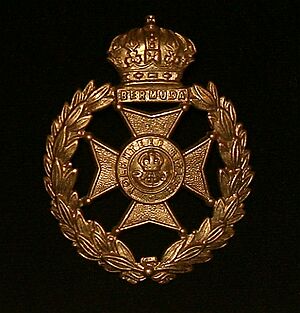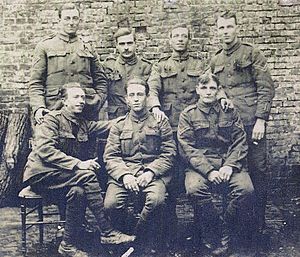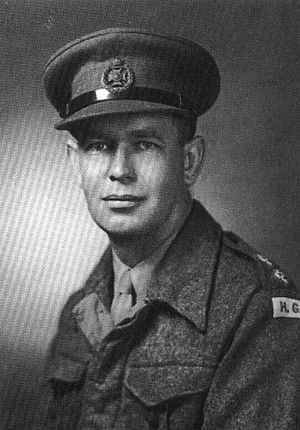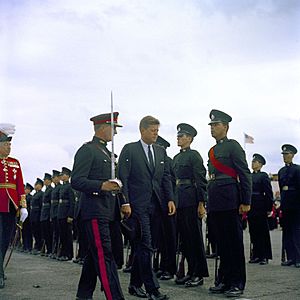Bermuda Volunteer Rifle Corps facts for kids
Quick facts for kids The Bermuda Volunteer Rifle Corps |
|
|---|---|
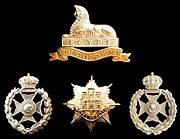
Badges of the Bermuda Volunteer Rifle Corps (left), the Bermuda Rifles (as the BVRC was retitled between 1951 and 1965, right), the Royal Lincolnshire Regiment (top), and its successor, the Royal Anglian Regiment (bottom-centre)
|
|
| Active | 1894–1965 |
| Country | Bermuda (United Kingdom overseas territory) |
| Branch | Army |
| Type | Rifle regiment |
| Size | Three rifle companies |
| Garrison/HQ | Bermuda Garrison |
The Bermuda Volunteer Rifle Corps (BVRC) was a special military group formed in Bermuda in 1894. It was like a backup team for the main British Army soldiers stationed there. Later, in 1951, its name changed to the Bermuda Rifles. Finally, in 1965, it joined with another group to become the Bermuda Regiment.
Contents
How the BVRC Started
Bermuda used to have its own local defense group, called a militia, from 1612 until 1815. But after the American War of 1812, this group wasn't needed as much because many regular British soldiers were stationed in Bermuda.
The main reason for these soldiers in Bermuda was to protect the important Royal Naval Dockyard on Ireland Island. This dockyard was a key base for the British Navy. The first line of defense was big guns along the coast, managed by the Royal Garrison Artillery (RGA). A volunteer group, the Bermuda Militia Artillery (BMA), was also created to help with these guns.
The BVRC was formed in 1894 to act as infantry (foot soldiers). Their job was to fight any enemy forces that managed to land on Bermuda's beaches.
The BVRC was set up by a law passed in Bermuda in 1892. It started with three groups, called companies, located in different parts of Bermuda. Later, a fourth company was added. The group had 12 officers and four permanent staff members from the regular army. The goal was to have 300 members in total. The lowest rank in the BVRC was "Rifleman," which was like a "private" in other army groups.
At first, only white men aged 17 to 50 could join the BVRC. This was because you had to be a member of a rifle club, and these clubs only allowed white members. Joining was voluntary, and members could leave with two weeks' notice, unless they were called up for active duty or training.
The BVRC members received their uniforms and equipment for free. Their uniform was dark green with black buttons, like other rifle groups. From 1898, they also got khaki uniforms. Members had to attend drills, pass inspections, and complete shooting tests to be considered "efficient." The group could be called into action during wartime or if Bermuda was attacked, but members couldn't be sent overseas without agreeing to it.
The Great War (World War I)

The BVRC continued to train for about 20 years. When World War I started in 1914, the BVRC was called up to help protect Bermuda. They guarded the coastline and helped defend the Royal Navy's dockyard, which was important for guiding ships across the Atlantic Ocean in convoys.
BVRC Soldiers Go Overseas
Even though their main job was in Bermuda, the BVRC quickly formed a group of volunteers in December 1914 to send to the Western Front in Europe. This group trained in Bermuda and included Captain Richard J. Tucker and 88 other soldiers. The Governor of Bermuda, Lieutenant-General Sir George Bullock, helped lead this group, which was nicknamed Bullock's Boys.
The group left Bermuda in June 1915 and traveled to England. They hoped to join the 2nd Battalion of The Lincolnshire Regiment, which had been in Bermuda before the war. Instead, they joined the 3rd Lincolnshire Regiment. The War Office made sure the Bermudian soldiers stayed together as a unit and kept their own BVRC badge. They were then attached to the 1st Lincolnshire Regiment in France in July 1915. This was the first volunteer group from a British colony to reach the front lines.
By the summer of 1916, many soldiers from this first group had been injured or killed. The remaining survivors joined with a second group of BVRC volunteers who had just arrived from Bermuda. This combined group was trained to use Lewis light machine guns. By the end of the war, over 75% of the combined group had been lost. Forty soldiers died, and many received awards for their bravery. Some BVRC soldiers even became officers in other units, including flying ace Arthur Rowe Spurling who joined the Royal Flying Corps (the early air force).
By the end of the war, the BVRC had earned several battle honors, including Ypres 1915 and Somme 1916.
Between the World Wars
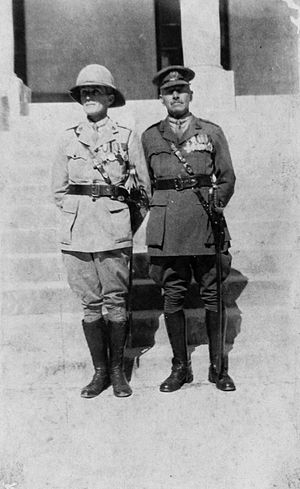
After World War I, the BVRC was temporarily stopped, but it was soon restarted with new members. Many former soldiers rejoined. In Britain, volunteer forces were reorganized into the Territorial Army (TA). This meant that volunteers had to serve for a set period, like professional soldiers.
The BVRC was reorganized to be like a "Territorial" unit, even though it was still called a Volunteer unit. It officially became linked with the Lincolnshire Regiment. In 1931, another local volunteer group, the Bermuda Volunteer Engineers (BVE), was formed to help with coastal defenses.
In 1928, the regular British Army soldiers who managed artillery and engineering left Bermuda. The BMA and BVE took over these roles completely.
World War II

The BVRC began getting ready for war on September 3, 1939, even before Britain officially declared war on Germany. Just like in World War I, they guarded the coastlines. More duties were added, and in October 1940, conscription (forcing people to join the military) was introduced to increase their numbers. Another infantry unit, the Bermuda Militia Infantry, was formed in October 1939, for black soldiers.
Again, a group of BVRC volunteers was sent overseas to fight. They left Bermuda in June 1940 and joined the Lincolnshire Regiment in England. Some of these Bermudian officers became Company Commanders in the Lincolns.
At first, Bermuda stopped sending more soldiers overseas to make sure there were enough defenders at home. This rule was lifted in 1943. In May 1944, another group of BVRC soldiers left Bermuda to join the Lincolns in England. They were re-badged as Lincolns and many joined the 2nd Lincolns in Belgium as the Allies moved through Europe. Some of these volunteers even trained as parachutists to join the Airborne Division.
After World War II

After World War II, the BVRC soldiers who had served in Europe returned home. In 1946, both the BVRC and the BMA were mostly stopped, with only a small leadership team remaining. However, in 1953, both groups were brought back to full strength.
At this time, the BVRC was renamed the Bermuda Rifles. The word "volunteer" was removed, likely because conscription was brought back for both units. In 1953, it was announced that the Royal Naval Dockyard would close. This meant the military base, which was there to protect the dockyard, would also close. The last regular British Army unit left Bermuda by 1955, and the Dockyard closed in 1958.
Even though the main reason for their existence was gone, the Bermuda government decided to keep the Bermuda Rifles and BMA going, paying for them itself.
In the 1960s, Bermuda faced some social tensions. It became clear that having two separate military units based on race was not a good idea. So, in September 1965, the Bermuda Rifles and the Bermuda Militia Artillery joined together to form the Bermuda Regiment (now called the Royal Bermuda Regiment).
The badge of the Royal Bermuda Regiment combines parts of the old BVRC badge and the Royal Artillery badge. The new unit continues the history and traditions of both its older parts.
Images for kids
See also
- Bermuda Garrison
- Bermuda Militias 1612-1815
- Volunteer Force (Great Britain)
- British Army


